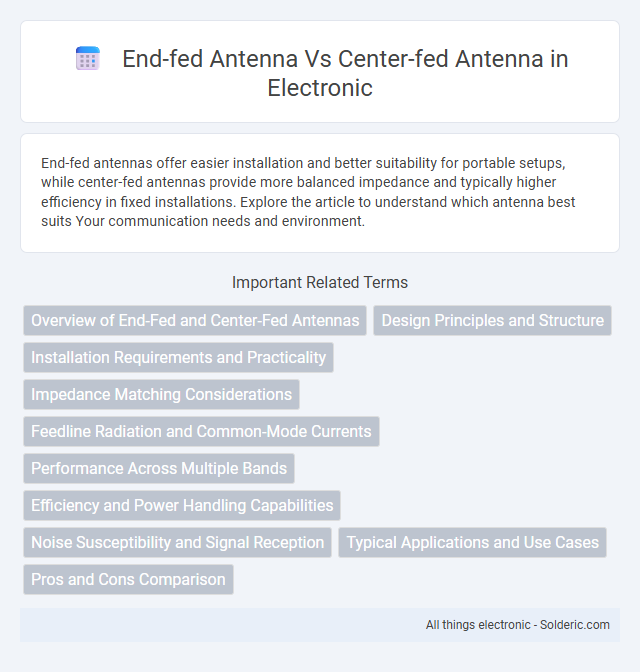End-fed antennas offer easier installation and better suitability for portable setups, while center-fed antennas provide more balanced impedance and typically higher efficiency in fixed installations. Explore the article to understand which antenna best suits Your communication needs and environment.
Comparison Table
| Feature | End-Fed Antenna | Center-Fed Antenna |
|---|---|---|
| Feed Point | At one end of the antenna | At the center of the antenna |
| Impedance | High impedance, often requires matching network | Generally low to moderate impedance, easier to match |
| Installation | Simple, one support point needed | Requires two support points |
| Common Usage | Portable and stealth setups | Standard HF radio installations |
| Radiation Pattern | Directional, can vary based on environment | Omnidirectional or predictable |
| Bandwidth | Narrower bandwidth | Wider bandwidth |
| Efficiency | Potentially lower due to matching losses | Higher efficiency, less feedline loss |
Overview of End-Fed and Center-Fed Antennas
End-fed antennas are typically simpler to install, requiring only one support point, and are favored for portable or limited-space setups, operating efficiently with a single-wire feed at the antenna's end. Center-fed antennas, such as dipoles, receive feed at their midpoint, providing balanced impedance and often better performance in terms of radiation pattern and bandwidth, making them suitable for fixed installations. Both designs impact antenna system matching and tuning requirements differently, influencing overall transmission efficiency in HF and VHF radio applications.
Design Principles and Structure
End-fed antennas feature a single-feed point at one end of the antenna wire, relying on the antenna's length and a matching network to achieve proper impedance transformation, making them compact and easy to deploy in restricted spaces. Center-fed antennas are fed at the midpoint, creating symmetrical current distribution and typically requiring a balanced feedline or a balun to maintain signal integrity and impedance matching. The structural difference affects feedpoint impedance and radiation pattern, with center-fed designs often delivering more efficient and balanced radiation characteristics compared to end-fed configurations.
Installation Requirements and Practicality
End-fed antennas require a simple installation with a single feed point, making them ideal for limited space and quick setups, often needing an antenna tuner for impedance matching. Center-fed antennas demand balanced feedlines and typically require a symmetrical support structure, such as two masts or trees, which can complicate installation but improve radiation efficiency. Practicality favors end-fed antennas for portable or constrained environments, while center-fed models suit permanent installations with ample support resources.
Impedance Matching Considerations
End-fed antennas typically have high impedance at the feed point, often requiring an impedance matching transformer or an antenna tuner to achieve efficient power transfer. Center-fed antennas usually present a lower, more manageable impedance near 50 to 75 ohms, allowing for easier direct connection to standard coaxial cables and minimizing signal loss. Your choice between these types affects the complexity and performance of the impedance matching network needed for optimal antenna operation.
Feedline Radiation and Common-Mode Currents
End-fed antennas often experience higher feedline radiation and increased common-mode currents, as the unbalanced feed configuration causes current to flow along the coax shield, leading to RF interference and pattern distortion. Center-fed antennas, with a balanced feedpoint and use of a balun, minimize common-mode currents on the feedline, reducing unwanted radiation and improving overall antenna performance. Effective suppression of common-mode currents in center-fed designs enhances signal purity and reduces noise pickup compared to end-fed configurations.
Performance Across Multiple Bands
End-fed antennas often exhibit varied performance across multiple bands due to their impedance characteristics and reliance on matching networks, which can result in narrower bandwidth and less consistent radiation patterns. Center-fed antennas typically provide better multi-band performance with more uniform impedance matching and stable radiation efficiency, making them ideal for broadband or multi-band operation. Your choice depends on the need for simplicity and portability versus consistent, high-quality transmission across varied frequencies.
Efficiency and Power Handling Capabilities
Center-fed antennas typically exhibit higher efficiency due to symmetrical current distribution, minimizing losses and ensuring better impedance matching compared to end-fed antennas, which often face higher reactance and reduced radiation efficiency. Power handling capabilities are generally superior in center-fed designs because the feed point impedance is lower, allowing them to manage higher voltages and currents without arcing or damage, whereas end-fed antennas may require additional components like matching transformers to safely handle equivalent power levels. Efficient energy transfer and robust power handling are critical for optimal performance in high-power transmission scenarios, favoring center-fed antennas for demanding applications.
Noise Susceptibility and Signal Reception
End-fed antennas often exhibit higher noise susceptibility due to their single-feed point design, which can pick up more unwanted electromagnetic interference along the entire length of the wire. Center-fed antennas typically provide better signal reception by offering a balanced feed point, reducing common-mode noise and improving overall signal-to-noise ratio. Your choice between these antennas should consider the operating environment, where quieter reception is essential for optimal performance.
Typical Applications and Use Cases
End-fed antennas are commonly used in portable and stealthy setups, ideal for amateur radio operators needing quick deployment and minimal space, especially in field operations or emergency communications. Center-fed antennas excel in fixed installations such as base stations and repeaters, providing balanced feed points that enhance performance for long-distance and high-power transmissions. Your choice depends on portability needs and installation constraints, with end-fed antennas favoring mobility and center-fed designs suited for permanent, performance-critical applications.
Pros and Cons Comparison
End-fed antennas offer easy installation with a single feed point, making them ideal for limited space or portable setups, but often require an impedance matching device to function efficiently. Center-fed antennas provide balanced feed characteristics, typically resulting in better radiation patterns and lower loss, yet they need a feed line running to the antenna's midpoint, which can complicate setup and deployment. End-fed versions tend to be more susceptible to noise and interference, whereas center-fed antennas generally offer improved signal clarity and multi-band operation capabilities.
end-fed antenna vs center-fed antenna Infographic

 solderic.com
solderic.com